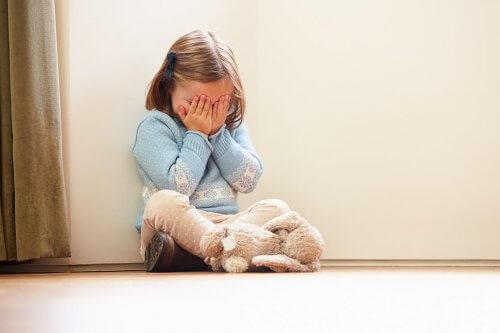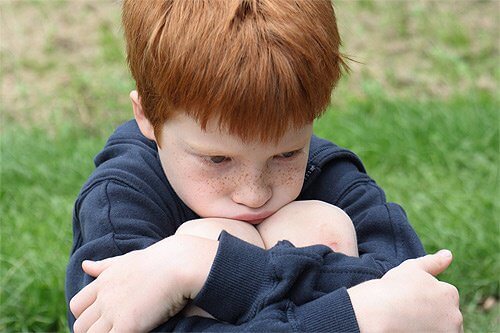The Importance of Teaching Children About Emotions at Home

Most of the times we adults cannot handle our own emotions, which makes it much more difficult to deal with our kids’. Teaching children about emotions is no easy task, however it isn’t impossible either.
Just as with illnesses, it’s often better to be safe than sorry. That’s why it’s crucial to try teaching about emotions at home before our children’s inability to communicate and express them calls for specialized treatment or therapy.
Consequently, it’s important for children to engage in activities and tasks with their parents in which they can express their emotions through movement, drawing or cooking.
The importance of defining our emotions
Emotions are our most loyal friends. In fact, they’re usually so interiorized that sometimes it’s hard to realize how to identify and sort them properly. When someone asks us how we feel, the answer is likely to be “fine” or “very well.”
However, is this how we really feel? Our vocabulary is often poor when we try to name our emotions. This means we’d usually rather give a vague and positive answer.
Recognizing our own emotions and understanding how we feel is a starting point that will help us know ourselves deeply, give meaning to many of our actions and be able to better manage and be in charge of our reactions.

Emotions at different ages
Even since we’re born, emotions are a part of us, and all of them are necessary and adaptable. Nevertheless, some emotions are more likely to come up in some ages than in others. Here are some examples:
- The fear of the unknown manifests between 9 months and 2 years of age.
- Frustration appears at around 2 or 3 years of age.
- Fear of the dark presents itself approximately at 5 years of age.
- Pride comes through in the first school years, caused by children needing to do things by themselves.
- Envy is born at 7, when children begin to compare themselves to their colleagues.
- Guilt starts to develop during the school years.
- Shame becomes more obvious during preadolescence.
- Loneliness is accentuated during adolescence.
“Teaching children about emotions at home means not only knowing how to identify them, but also helping our children to manage and control them whenever necessary.”
Emotion denial
A great problem that our society faces is the constant denial of upsetting emotions, which are also essential to our daily life. Anger, rage or fear are necessary in the right measure. The key lies in identifying them and using them correctly.
For example, anger is difficult to express in a nice way, without extreme exaggeration or provocation. However, this is usually our mechanism to express something we don’t like. Similarly, fear makes us act more carefully, but when excessive it can get to the point of blocking our mind.
Teaching children about emotions at home
According to experts, education has evolved with time. Emotions gain relevance thanks to the views of many scientific papers which claim that our success depends fundamentally on our emotional and social intelligence.
Lately it has been proven that teaching facilities focusing on emotional teaching obtain better academic results. Their alumni also have a better ability to scale down and solve conflict.

More so, families slowly become more important in this matter. Fathers and mothers go to parenting schools to learn about the correct way to talk to their children and pay attention to their emotions.
Parents must learn as well
Family is the first place where bonds, relationships and emotions develop. Parents are role-models and guides for their children to follow. So before we try teaching children about emotions at home, it’s fundamental for parents to balance and learn to control their own.
“Preparing and guiding children through expressing their emotions enhances their social and individual development.”
The key for the correct development of children starts with emotional teaching at home. If they receive a strong emotional education from an early age, they will be able to properly face the problems and difficulties that may arise when they are adults.
Most of the times we adults cannot handle our own emotions, which makes it much more difficult to deal with our kids’. Teaching children about emotions is no easy task, however it isn’t impossible either.
Just as with illnesses, it’s often better to be safe than sorry. That’s why it’s crucial to try teaching about emotions at home before our children’s inability to communicate and express them calls for specialized treatment or therapy.
Consequently, it’s important for children to engage in activities and tasks with their parents in which they can express their emotions through movement, drawing or cooking.
The importance of defining our emotions
Emotions are our most loyal friends. In fact, they’re usually so interiorized that sometimes it’s hard to realize how to identify and sort them properly. When someone asks us how we feel, the answer is likely to be “fine” or “very well.”
However, is this how we really feel? Our vocabulary is often poor when we try to name our emotions. This means we’d usually rather give a vague and positive answer.
Recognizing our own emotions and understanding how we feel is a starting point that will help us know ourselves deeply, give meaning to many of our actions and be able to better manage and be in charge of our reactions.

Emotions at different ages
Even since we’re born, emotions are a part of us, and all of them are necessary and adaptable. Nevertheless, some emotions are more likely to come up in some ages than in others. Here are some examples:
- The fear of the unknown manifests between 9 months and 2 years of age.
- Frustration appears at around 2 or 3 years of age.
- Fear of the dark presents itself approximately at 5 years of age.
- Pride comes through in the first school years, caused by children needing to do things by themselves.
- Envy is born at 7, when children begin to compare themselves to their colleagues.
- Guilt starts to develop during the school years.
- Shame becomes more obvious during preadolescence.
- Loneliness is accentuated during adolescence.
“Teaching children about emotions at home means not only knowing how to identify them, but also helping our children to manage and control them whenever necessary.”
Emotion denial
A great problem that our society faces is the constant denial of upsetting emotions, which are also essential to our daily life. Anger, rage or fear are necessary in the right measure. The key lies in identifying them and using them correctly.
For example, anger is difficult to express in a nice way, without extreme exaggeration or provocation. However, this is usually our mechanism to express something we don’t like. Similarly, fear makes us act more carefully, but when excessive it can get to the point of blocking our mind.
Teaching children about emotions at home
According to experts, education has evolved with time. Emotions gain relevance thanks to the views of many scientific papers which claim that our success depends fundamentally on our emotional and social intelligence.
Lately it has been proven that teaching facilities focusing on emotional teaching obtain better academic results. Their alumni also have a better ability to scale down and solve conflict.

More so, families slowly become more important in this matter. Fathers and mothers go to parenting schools to learn about the correct way to talk to their children and pay attention to their emotions.
Parents must learn as well
Family is the first place where bonds, relationships and emotions develop. Parents are role-models and guides for their children to follow. So before we try teaching children about emotions at home, it’s fundamental for parents to balance and learn to control their own.
“Preparing and guiding children through expressing their emotions enhances their social and individual development.”
The key for the correct development of children starts with emotional teaching at home. If they receive a strong emotional education from an early age, they will be able to properly face the problems and difficulties that may arise when they are adults.
All cited sources were thoroughly reviewed by our team to ensure their quality, reliability, currency, and validity. The bibliography of this article was considered reliable and of academic or scientific accuracy.
- Bisquerra, R. (2011). Educación emocional. Propuestas para educadores y familias. Bilbao: Desclée de Brower. http://otrasvoceseneducacion.org/wp-content/uploads/2019/04/Educación-Emocional.-Propuestas-para-educadores-y-familias-Rafael-Bisquerra-Alzina-2.pdf
- Goleman, D. (2010). La práctica de la inteligencia emocional. Editorial Kairós.
- López, M. (2008). La integración de las habilidades sociales en la escuela como estrategia para la salud emocional. Psicología sin fronteras: revista electrónica de intervención psicosocial y psicología comunitaria, 3(1), 16-19.
- Shapiro, L. E. (2002). La salud emocional de los niños (Vol. 16). Edaf.
- Ekman, P. E., & Davidson, R. J. (1994). The nature of emotion: Fundamental questions. Oxford University Press.
- Ekman, P. (1992). Are there basic emotions? https://psycnet.apa.org/doiLanding?doi=10.1037/0033-295X.99.3.550
- Ekman, P. (1999). Basic emotions. Handbook of cognition and emotion, 98(45-60), 16.
This text is provided for informational purposes only and does not replace consultation with a professional. If in doubt, consult your specialist.








